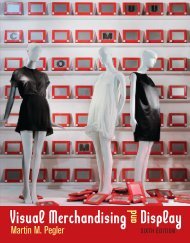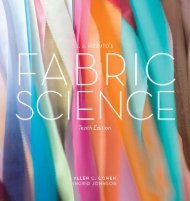Integrating Draping, Drafting, & Drawing - Fairchild Books
Integrating Draping, Drafting, & Drawing - Fairchild Books
Integrating Draping, Drafting, & Drawing - Fairchild Books
You also want an ePaper? Increase the reach of your titles
YUMPU automatically turns print PDFs into web optimized ePapers that Google loves.
<strong>Integrating</strong> <strong>Draping</strong>, <strong>Drafting</strong>, and <strong>Drawing</strong><br />
Preface<br />
This book is about a dialog between an artist<br />
and a technician. It illustrates the design process,<br />
encompassing sketch and garment pattern development.<br />
It depicts the relationship among three<br />
disciplines of fashion design: draping, drafting,<br />
and drawing. The integration is presented in a<br />
highly visual format.<br />
These disciplines, particularly draping and<br />
drafting, are often taught in separate classes.<br />
Their relationship is integral to efficient and timesaving<br />
methods of developing a design and its<br />
pattern. Our aim is to create bridges between<br />
studio methods and design illustration. Each<br />
chapter renders a combination of skills and the<br />
natural flow among them. Two-dimensional<br />
design informs the three-dimensional and vice<br />
versa.<br />
Chapters are presented as hands-on learning<br />
experiences with lessons that mimic classroom<br />
demonstrations. Step-by-step photography portrays<br />
the draping process in a sculptural way<br />
rather than using illustrations, which cannot truly<br />
depict the response of fabric draped on a dress<br />
form. The images of muslin “sculpture” combined<br />
with digital drafts offer interchangeable<br />
solutions for pattern development.<br />
Throughout the book, there are alternative<br />
methods used by practicing designers for developing<br />
slopers. These are master patterns, created<br />
by draping or drafting and used to generate style<br />
variations. We chose the basic components of the<br />
dress as the model used throughout the text to<br />
demonstrate how draping, drafting, and drawing<br />
are integrated in design development. The components<br />
are the skirt, bodice, neckline, collar,<br />
sleeve, and dress foundation. These disciplines<br />
are similarly integrated in the design of men’s and<br />
children’s wear.<br />
Each chapter builds on the last. After an<br />
introduction to tools and preparation techniques<br />
in Chapter 1, Chapters 2, 3, and 6 begin with<br />
draping as the first step in producing a sloper.<br />
<strong>Drafting</strong> the sloper is then offered as an alternative<br />
method. Chapters 4, 5, and 7, focusing<br />
respectively on bodice variations, necklines and<br />
collars, and dresses, begin with drafting because,<br />
for many of the design variations, these chapters<br />
utilize slopers developed in the previous chapters.<br />
In the case of a design variation such as the leg-omutton<br />
sleeve, for example, drafting the pattern<br />
is more efficient than draping it.<br />
All design starts with an idea, which needs to<br />
be translated into a sketch. <strong>Drawing</strong> basics are<br />
interwoven throughout the book, with an emphasis<br />
on understanding body lines in relation to the<br />
dress form and proportion. It is directed toward<br />
communicating specific garment detail in the context<br />
of related projects. Lessons ground the creative<br />
process and strike a balance between the<br />
technical and visual elements. <strong>Drawing</strong> informs<br />
draping and drafting, just as these disciplines<br />
inform drawing. Step-by-step instructions on<br />
PREFACE<br />
|xi













